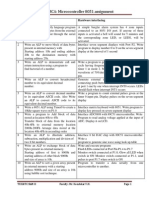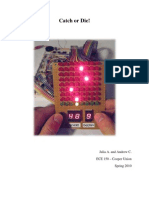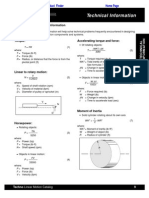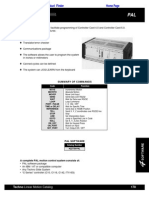5051 App
5051 App
Uploaded by
awemetalCopyright:
Available Formats
5051 App
5051 App
Uploaded by
awemetalOriginal Title
Copyright
Available Formats
Share this document
Did you find this document useful?
Is this content inappropriate?
Copyright:
Available Formats
5051 App
5051 App
Uploaded by
awemetalCopyright:
Available Formats
File under INTEGRATED CIRCUITS, <Handbook> Nov 96
INTEGRATED CIRCUITS
Philips Semiconductors
TDA5051
ASK Power Line Modem
APPLICATION NOTE
Eric MICHAT
Nov 96 2
Philips Semiconductors
ASK Power Line Modem TDA5051
APPLICATION NOTE
SUMMARY
1. INTRODUCTION
1.1 TDA5051 - ASK MODEM FOR POWER LINE DATA TRANSMISSION 3
1.2 BLOCK DIAGRAM 4
1.3 PINNING AND FUNCTION DESCRIPTION 5
( see DATA SHEET for a complete description of the device)
2. COMPLIANCE WITH STANDARDS
2.1 COMPLIANCE WITH EN50065-1 6
2.2 COMPLIANCE WITH EN50065-2 (project stage) 8
3. COUPLING WITH THE POWER LINE
3.1 INTRODUCTION 10
3.2 LOW COST COUPLING - FILTER DESIGN AND CHARACTERISTICS 12
3.3 HF TRANSFORMER COUPLING 19
3.4 TRANSIENT AND OVERVOLTAGE PROTECTION 25
4. COUPLING WITH THE CONTROLLER 28
4.1 CLOCK CONFIGURATIONS
4.2 DATA AND POWERDOWN SIGNALS 30
5. POWER SUPPLY DESIGN
5.1 POWER CONSUMPTION 33
5.2 EXAMPLE OF R-C POWER SUPPLY 35
5.3 EXAMPLE OF SWITCHING MODE POWER SUPPLY 37
Page
Nov 96 3
Philips Semiconductors
ASK Power Line Modem TDA5051
APPLICATION NOTE
1. INTRODUCTION
1.1 TDA 5051 - ASK MODEM FOR POWER LINE DATA TRANSMISSION
The TDA5051 is a complete ASK MODEM dedicated to data transmission on power line network, requiring very few
external components. It could be also used on any two wire network for exchanging informations by means of ASK carrier
current technique (DC or AC network).
The use of a digital structure for both transmission and reception part provides an efficient solution for modulating and
demodulating low Baud rate data signals. A standard quartz crystal is required to set the operation frequency; in
transmission mode, it defines the carrier frequency and in reception mode it defines the detection frequency.
Main features of the IC:
CMOS process IC: low power consumption, reliability and high temperature stability, on-chip ESD protection.
Single +5V Power Supply: the same power supply can be used to feed the controller.
On-chip clock circuit: using an external quartz crystal, the oscillator sets the operation frequency and the clock output
pin gives the possibility to supply the clock to a microcontroller. It is also possible to apply an external clock signal to
the chip by using one of the oscillator pins as an input.
Full digital modulation with signal shaping: using ROM and a 6-bit D/A converter provides high stability of the
carrier frequency, limitation of the signal bandwidth and easy choice of the frequency within a large range.
On-chip power amplifier with overload protection: low distortion, low output impedance amplifier for limiting the
number of external components and the size of the complete system. An internal feedback controls the output voltage
to comply with the EN50065-1 standard (122dBuV maxi rms).
Input amplifier with Automatic Gain Control: provides a very high sensitivity of 66 dBuV rms, allowing the detection
of small signals in heavy loaded power line conditions.
Digital Narrowband Filter with 8-bit A/D converter: equivalent to a 8th order analogue filter, for an accurate and
sharp filtering of the input signal.
Digital Demodulation: a digital demodulator with variable threshold calculates the optimum level in order to restore
the baseband signal with the highest accuracy.
600 Baud typical rate, 1200 Baud MAX.
TTL / CMOS compatible data pins: for direct connection to the controller.
Digital Part fully Scan testable: for a complete digital production check, before and after packaging of the IC.
Low cost external coupling network: using a simple LC filter without any tunable components.
Fig.1 Typical application with power line modems
TDA5051
uC
Power Supply
Coupling
and
TDA5051
uC
Power Supply
Coupling
and
User
Appl.
User
Appl.
230V
Line
Nov 96 4
Philips Semiconductors
ASK Power Line Modem TDA5051
APPLICATION NOTE
1.2 BLOC DIAGRAM
Fig.2 Data transmission using ASK with NRZ code
1
0 0 1 0 0 1
TX uC Binary
sequence
DATA_IN
TRANSMITTER
LINE
DATA_OUT
RECEIVER
1
0 0 1 0 0 1
RX uC Binary
sequence
START BIT
START BIT
DIGITAL
DEMOD.
DIGITAL
BANDPASS
FILTER
A/D
RXIN 14
15
9
10
PD
GndAP
TXOUT
VddAP
D/A
6
R.O.M.
GndD GndA VddA VddD
5 12 13 3
CONTROL LOGIC DATA_IN 1
CLK_OUT 4
7
8
OSC1
OSC2
DATA_OUT
U/D
COUNT
PEAK
DETECT
16 6
SCANTEST TEST1
2
11
POWER
DRIVE
OSC /2
Fig.3 Bloc diagram
Nov 96 5
Philips Semiconductors
ASK Power Line Modem TDA5051
APPLICATION NOTE
1.3 PIN DESCRIPTION
Table 1
Note
SYMBOL PIN DESCRIPTION
DATA_IN 1 Digital Data input (Active-low)
DATA_OUT 2 Digital Data output (Active-low)
VddD 3 Digital supply
CLK_OUT 4 Clock output
GndD 5 Digital ground
SCANTEST 6 Test input (Low in application)
OSC1 7 Oscillator input
OSC2 8 Oscillator output
GndAP 9 Analog ground for power amplier only
TXOUT 10 Analog Signal output (DC coupled)
VddAP 11 Analog supply for power amplier only
GndA 12 Analog ground
VddA 13 Analog supply
RXIN 14 Analog Signal input (DC coupled)
PD 15 Power Down input (Active-high)
TEST1 16 Test input (High in application)
PIN 6 - SCANTEST On-chip Pull Down resistor
PIN 15 - PD On-chip Pull Down resistor
PIN 16 - TEST1 On-chip Pull Up resistor
16
15
14
13
12
11
10
9
8
1
2
3
4
5
6
7
TDA5051
TEST1
PD
RXIN
VDDA
GNDA
VDDAP
TXOUT
GNDAP
OSC2
OSC1
SCANTEST
GNDD
CLK_OUT
VDDD
DATA_OUT
DATA_IN
Fig.4 Pinning of the TDA5051 - SO16L Package (SOT 162 AH14)
Nov 96 6
Philips Semiconductors
ASK Power Line Modem TDA5051
APPLICATION NOTE
2. COMPLIANCE WITH STANDARDS
2.1 Compliance with the EN50065-1 ( Main points only - Please refer to the norm for further details).
Choice of the carrier frequency.
The operating frequency of the modem is only defined by the choice of the quartz crystal or by the frequency of the
signal applied at the oscillator input, as shown in this table.:
Table 2
However, to comply with the EN50065-1 norm, the carrier frequency for power line data transmission must be chosen
within the following range:
Table 3
In order to avoid problems with the bandwidth of the modulated signal, it would be better to choose a carrier frequency
(which is in fact a centre frequency) higher than 95KHz and lower than 148.5KHz; for example 98KHz to 145.5KHz is a
good compromise.
Then, the oscillator frequency range is 64 times higher than these two values, which gives 6.272MHz to 9.312MHz.For
the special frequency of 132.5KHz, a crystal of 8.48MHz should be used.
For instance, using commercial quartz crystals gives the following set of carrier frequencies: (Note that 8.48MHz is still
not a standard frequency...)
Table 4
OSCILLATOR
FREQUENCY
CLOCK OUTPUT
FREQUENCY
CARRIER AND DETECTION
FREQUENCY
Fosc Fosc / 2 Fosc / 64
9KHz to 95KHz 95KHz to 125KHz 125KHz to 140KHz 140KHz to 148.5KHz
Restricted
use
Free for consumers Free for consumers Free for consumers
No access protocol Requested protocol:
Use 132.5KHz to inform that a
transmission is in progress
No access protocol
Fosc
XTAL
MHz
Fclock_out
Clock Output Pin
MHz
Fc
Carrier
KHz
6.553600 * 3.27680 102.4
7.372800 * 3.68640 115.2
7.864320 * 3.93216 122.88
8.000000 * 4.00000 125.00
8.192000 * 4.09600 128.00
8.480000 - 4.24000 132.50
8.867230 * 4.43361 138.55
Nov 96 7
Philips Semiconductors
ASK Power Line Modem TDA5051
APPLICATION NOTE
Modem output voltage
The maximum output voltage of a power line modem is also defined by the norm, and the measurement of this voltage
must be performed as described in the EN50065-1.
Basically, it consists of measuring, with a 50 Ohms spectrum analyser, the carrier amplitude of the complete system
(modem+coupling network) on a standard load, called the CISPR16 load.
The CISPR16 Network provides an attenuation of 6dB, due to its structure. The maximum rms voltage measured on the
analyser must be in the following range:
Table 5
The internal power amplifier of the TDA5051 is designed to supply the voltage required for domestic applications; of
course, for a higher voltage value, an extra power amp should be used.
Limiting conducted power line disturbances
One of the most important points of the EN50065-1 standard concerns the amplitude limitation of non-expected
harmonics outside the transmission band. To be officially approved, this test requires specific equipment, but a
measurement with a CISPR16 network and a 50 Ohms analyser (resolution bandwidth of 9KHz) can give a good idea
of the conducted disturbances.
Anyway, the peak value of these harmonics must be within the following limitis:
Table 6
Domestic use only Industrial or specic use
MAX 116 dBuV with CISPR16 network MAX 134dBuV with CISPR16
Effective value at the modem output is
122 dBuV
3.56 V peak to peak
Effective value at the modem output is
140 dBuV
28.3 V peak to peak
Frequency range (MHz) Peak limit (dBuV)
0.15 to 0.5 66 to 56
decreasing linearly with the log of frequency
0.5 to 5 56
5 to 30 60
230V
TDA5051
uC
Power Supply
Coupling
and
Filter
Section
CISPR16
NETWORK
SPECTRUM
ANALYSER
GND OUT
230 V
Fig.5 Test set-up for measuring Vout and conducted power line disturbances
50
Nov 96 8
Philips Semiconductors
ASK Power Line Modem TDA5051
APPLICATION NOTE
2.2 Compliance with EN50065-2 (project stage)
Immunity requirements - Narrow band conducted interferences
This is another important point of specification for power line modems, which is closely tied to the application.
The EN50065-2 (SC105A) norm defines the operation conditions of two systems (emitter and receiver) connected to
an artificial network, with a given level of conducted interference signal.
This signal, for the narrow band test, is a 80% 1KHz modulated sinewave, supplied by a signal generator as shown
in the following figure:
Then, this interference signal, is swept through a wide frequency range from 3KHz to 30MHz, excluding of course, the
band defined in table 3, in which the system operates. The interference signal must have the amplitude ( measured
unmodulated at the output of the generator) given in the following table:
Table 7
Frequency Range Interference
signal amplitude
Performance criterion of the complete system
3 - 8 KHz 134 dBuV The system shall continue to operate correctly
10 - 94 KHz 134 to 120 dBuV The system shall continue to operate correctly
96 - 124 KHz 134 dBuV Self recoverable temporary loss of function or performance
126 - 139 KHz 134 dBuV Self recoverable temporary loss of function or performance
141 - 147.5 KHz 134 dBuV Self recoverable temporary loss of function or performance
150 KHz - 30 MHz 130 dBuV Self recoverable temporary loss of function or performance
230V
TDA5051
uC
Power Supply
Coupling
and
TDA5051
uC
Power Supply
Coupling
and
Filter
CISPR16 NETWORK
Filter
CISPR16 NETWORK
50 Ohms Analyser
50 Ohms Generator
TRANSMITTER
RECEIVER
6
8
0
u
H
Fig.6 Test set-up for narrow band immunity
6
8
0
u
H
Nov 96 9
Philips Semiconductors
ASK Power Line Modem TDA5051
APPLICATION NOTE
The behaviour of the system during this test is not only dependant on the modem performances.The implemented
software of the application and the protocol may be decisive to successfully do this test.
However, these elementary rules should be used for designing the system:
1- Avoid the edges of the allowed bands by choosing a centred carrier frequency.
2- Design the external filter (see section 3) for high rejection of unexpected frequencies.
3- Implement a software able to perform multi-sampling on the received data signal.
4- Avoid open loop control - Use preferably an acknowledge based protocol.
5- If possible, use binary codes with error correction capabilities.
The structure of the TDA5051 has been designed to cope with severe test conditions, by using very efficient digital
filtering and a variable threshold demodulator. However, under certain operating conditions, correct detection is not
guaranteed.
Immunity requirements - Broad band noise interferences
For this test, the generator of the Fig.6 is replaced by a random noise generator producing an uniform spectrum from
3KHz to 150KHz, having a spectral density of 43dBuV / sqrt(Hz).
The system must operate correctly under these conditions.
The remarks 3, 4, 5 given above this section are still valid.
Input impedance of the power line equipment
In order to allow the coexistence of several power line modems on the same network, a minimum value of the input
impedance has been proposed by the SC105A standard.
That means, a guaranteed minimum input impedance for the coupling network (external filter) but also for the power
supply. These aspects are mentioned in the filter design section and in the power supply section.
This value has been set to 5 Ohms, in the frequency range of 95KHz to 148.5KHz.
Nov 96 10
Philips Semiconductors
ASK Power Line Modem TDA5051
APPLICATION NOTE
3. COUPLING WITH THE POWER LINE
3.1 INTRODUCTION
The coupling network is the interface between the power line and the low voltage TXOUT / RXIN pins of the modem. For
low cost applications, when the insulation with the mains is not required, a double LC network can be used, providing
efficiency without any adjustement or tunable components. When an insulation is mandatory, a HF transformer should
be used.
Decoupling TXOUT and RXIN pins
The following table shows the electrical characteristics of TX and RX pins in different operation modes:
Table 8
It is mandatory to provide a DC decoupling for both TXOUT and RXIN pins !
It is not possible to tie together TXOUT and RXIN, even if the DC offset is the same: the RXIN pin is very sensitive to
a small shift of the DC voltage which is intenally set to bias the input amplifier at an optimum level.
Characteristics of the TXOUT pin
Reception / Standby mode Transmission mode Power Down Mode
Impedance HIGH Approx. 5 HIGH
DC offset undened 2.5V undened
Characteristics of the RXIN pin
Reception / Standby mode Transmission mode Power Down Mode
Impedance 50 K 50 K 50 K
DC offset 2.5V 2.5V 2.5V
TDA5051
TXOUT
RXIN
GND
DECOUPLING
FILTER
LC
HF Transformer
DC
AND
PROTECTION
230V
LINE
Fig.7 Coupling with the power line
Coupling Network
or
Nov 96 11
Philips Semiconductors
ASK Power Line Modem TDA5051
APPLICATION NOTE
Filter:
The filter has two purposes:
- 1/ In reception mode: it provides an efficient rejection of the 50Hz signal (high pass) and anti-aliasing (low-pass) for
the digital filter. It is important to keep in mind that the digital filter is able to detect the Fc component of the carrier, but
also the +/-Fc components located around the sampling frequency (Fosc/2) and its multiples.
For instance, the 50Hz amplitude is 230V rms or 167dBuV, and the maximum sensitivity of the modem is 66dBuV; to
take advantage of the detection performance, the filter must reject the 50Hz of more than 100dB, which means an
efficiency higher than 30dB/decade.
For the anti-aliasing rejection around the sampling frequency, 50dB seems to be a good compromise...
- 2/ In transmission mode: it provides a rejection of unexpected harmonics in order to comply with the EN50065-1
standard. The carrier being synthesized by scanning a ROM, its spectrum is repeated around the sampling frequency
(Fosc/2) and its multiples (Fosc, 3Fosc/2, 2Fosc, etc.), with decreasing amplitude.
Fig.8 Digital Filter Detection and ideal bandpass filter
10M
50Hz
0dB
-50dB
-100dB
Fc
-Fc
Fs
+Fc 0
Detection
Bandwidth
Fs Fc
10K
Digital Filter Detection
Ideal BP filter
Fc Fs 2Fs
n.Fc harmonics due to quantization
errors and non linearity
Aliasing around n.Fs
116
dBuV
100K 1M 10M
100
50
95..148.5KHz Band
dBuV
EN50065-1 Template
Fig.9 Spectrum of the digital carrier and compliance with the standard
CISPR16 load
Nov 96 12
Philips Semiconductors
ASK Power Line Modem TDA5051
APPLICATION NOTE
3.2 LOW COST COUPLING
3.2.1 INTRODUCTION
This coupling uses a double LC bandpass filter. It does not provide any insulation from power line.
DC decoupling of TXOUT and RXIN
The values of Cdtx and Cdrx are not critical.
Cdtx must be chosen to provide a low impedance at the carrier frequency (less than 1 for instance).The table 9 shows
the recommended values for these capacitors.
Table 9
Design of the LC filter
The LC filter must be tuned for the chosen carrier frequency. One can use the simple formula:
With Fc and Fosc in Herz, L in Henry and C in Farad.
RECOMMENDED VALUES FOR CDRX AND CDTX CAPACITORS
Cdtx 1uF to 10uF non polarized electrolytic
Cdrx 1nF to 10nF ceramic or plastic
line 230V ac
Rz
TXOUT
RXIN
10
14
5 9 12
Ls Cs
Lp
Cp1- 2
TDA5051
Cdtx
Cdrx
Fig.10 Low cost coupling using a LC bandpass filter
CAUTION !
NO INSULATION
BETWEEN LINE
AND SIGNALS
Fc
1
2 Ls Cs
----------------------------------
1
2 Lp Cp1 Cp2 + ( )
----------------------------------------------------------------
Fosc
64
-------------- = = =
Nov 96 13
Philips Semiconductors
ASK Power Line Modem TDA5051
APPLICATION NOTE
Apart from rejection characteristics mentioned above, the other features of this network should be:
- Minimum impedance in transmission for the Ls-Cs part of the filter: that means a low serial resistor for Ls and good
tuning at the carrier frequency. That also means a good balance between the values of Ls and Cs for the same tuning
frequency, taking into account the possible variation of standard components (+/-20 % for high voltage capacitors, +/-10
% or 5% for inductors).
- Minimum input impedance of the filter: if required, the Rz resistor (Fig. 10) can be chosen from 0 to 5.6 Ohms, in order
to limit the minimum input impedance of the filter (EN standard is at a project stage about this point).
Warning: one have to take into account that a too high value for Rz may affect the rejection of HF harmonics in
transmission (The best rejection is carried out with Rz=0).
The following table shows an example of values for the filter components, according to standard quartz crystals.
Depending on the complete application of the customer (power supply, routing of the board, placement, etc.),
the compliance with EN50065-1 is not guaranteed. and must be checked anyway.
Table 10
Notes
1. XTAL * are standard HC49 quartz crystals; each carrier frequency belongs to the EN50065-1 transmission band.
2. 8.48MHz is still not a standard frequency.
3. Cs must be a X2 type capacitor, suited for 250 V AC line voltage; Ls is preferably a low Rs inductor.
3.2.2 DESIGN EXAMPLE OF A TYPICAL COUPLING NETWORK
Designer choices:
- Frequency band: no protocol used, so the 95KHz to 125KHz band is chosen.
- Carrier frequency: within this frequency range, a standard quartz crystal of 7.3728MHz gives a carrier of 115.2KHz.
- The components should be: Ls=47uH +/-10% with Rs=2 , Cs=47nF +/- 20% X2 (suited for 230V ac) , Lp=47uH +/-10%
with Rs=5 SMD inductor, Cp1=33nF 25V SMD, CP2=6.8nF SMD, Rz=5.6 .
- The decoupling Cdtx is a 10uF / 16V non polarized capacitor and Cdrx is a 10nF 25V SMD capacitor.
With this filter, one can simulate the reception transfer characteristics, the input impedance and the transmission transfer
characteristics on the standard load. It is also possible to simulate the losses in transmission on different resistive loads.
The last check for a coupling network consists of carrying out a spectrum measurement with a CISPR16 load; a real
example is given at the end of this chapter.
VALUES OF LS, LP, CP1, CP2, CS AND XTAL FOR DIFFERENT CARRIER FREQUENCIES
Fosc
XTAL
MHz
Fclock_out
MHz
Fc
Carrier
KHz
Ls
(Low Rs)
uH
Cs
(250Vac)
nF
Lp
uH
Cp1
nF
Cp2
nF
6.553600 * 3.27680 102.4 56 47 47 47 4.7
7.372800 * 3.68640 115.2 47 47 47 33 6.8
7.864320 * 3.93216 122.88 47 33 47 33 2.2
8.000000 * 4.00000 125.00 47 33 47 33 -
8.192000 * 4.09600 128.00 47 33 47 33 -
8.480000 - 4.24000 132.50 47 33 47 27 3.3
8.867230 * 4.43361 138.55 56 22 47 27 -
Nov 96 14
Philips Semiconductors
ASK Power Line Modem TDA5051
APPLICATION NOTE
a/ Reception mode - Transfer characteristic of the LC filter
b/ Reception mode - Input impedance of the LC filter
47uH
47nF
47uH
33nF 6.8nF
10nF
50K
(Zrxin)
Fig.11 Simulation diagram for the transfer characteristic
5.6
2
5
E
AC
Source
V
AC
Analysis
Fig.12 Bandpass filter - reception -- GdB versus Frequency
Note: 50Hz rejection > 90dB ; Rejection around Fs >45dB
10.0
100.0
1.0k
10.0k
100.0k
1.0M
10.0M
-140.0
-120.0
-100.0
-80.0
-60.0
-40.0
-20.0
0.0
20.0
(LIN)
GdB
F Hz
47uH
47nF
47uH
33nF 6.8nF
10nF
50K
(Zrxin)
Fig.13 Test set-up for measuring input impedance
5.6
2
5
E
AC
Source
A
AC
Analysis
Nov 96 15
Philips Semiconductors
ASK Power Line Modem TDA5051
APPLICATION NOTE
c/ Transmission mode - Transfer characteristic of the LC filter with a CISPR16 load
Fig.14 Input impedance - Zin versus Frequency
10.0
100.0
1.0k
10.0k
100.0k
1.0M
10.0M
1.0
10.0
100.0
1.0k
10.0k
(LOG)
A l i AC
Zin
F Hz
47uH
47nF
47uH
33nF 6.8nF
10uF
250 nF
50
5
5
50uH
250 nF
50uH
Fig.15 Measurement set-up - Transfer characteristic in transmission on CISPR16 load
5
2
5.6
E
AC
Source
V
AC
Analysis
50
Nov 96 16
Philips Semiconductors
ASK Power Line Modem TDA5051
APPLICATION NOTE
d/ Transmission mode - Efficiency of the LC filter
It could be usefull to simulate the efficiency of the coupling for different loads and for different marginal conditions in the
values of Cs and Ls. For this simulation, a fixed frequency and voltage generator is used with a serial resistor of 5 Ohms,
to represent the output amplifier.
The Fig. 18 shows the coupling efficiency on a resistive load, with optimum values for Cs=47nF and Ls=47uH; the
maximum rms level is 122dBuV and the minimum is 103dBuV, for 1 load.
The Fig.19 shows marginal conditions, with Cs=47nF +/-20% and Ls=47uH +/-10% (4 plots). In the worst case (47nF
+20%, 47uH +10%), the output voltage is still higher than 98dBuV for the maximum load. The variation of Cp and Lp has
no significant effect on the efficiency.
Fig.16 Bandpass filter - transmission - GdB versus Frequency
Note: Top of the curve: -6dB (due to the network)
10.0k
100.0k
1.0M
10.0M
100.0M
-70.0
-60.0
-50.0
-40.0
-30.0
-20.0
-10.0
0.0
(LIN)
-6dB
GdB
F Hz
47uH
47nF
47uH
33nF 6.8nF
10uF (Ztxout)
Fig.17 Simulation set-up - Vout= 20log(V*1e6) = f(Rload)
Rload
2
5
5
5.6 V
E
f=115KHz
Nov 96 17
Philips Semiconductors
ASK Power Line Modem TDA5051
APPLICATION NOTE
1.0
10.0
100.0
(LOG)
100.0
105.0
110.0
115.0
120.0
125.0
(LIN)
Analysis: AC
R_26
- y1-axis -
vout
- Subvar -
F: 115.5k
Fig.18 Vout(dBuV) versus load impedance - nominal values for filter components
1.0
10.0
100.0
(LOG)
95.0
100.0
105.0
110.0
115.0
120.0
125.0
(LIN)
Analysis: AC
R_26
- y1-axis -
vout
- Subvar -
F: 115.2k
L_12: 52.0u
C_9: 56.0n
2
F: 115.2k
L_12: 52.0u
C_9: 38.0n
3
F: 115.2k
L_12: 42.0u
C_9: 56.0n
4
F: 115.2k
L_12: 42.0u
C_9: 38.0n
Fig.19 Vout(dBuV) versus load impedance with +/-20% Cs and +/-10% Ls
Nov 96 18
Philips Semiconductors
ASK Power Line Modem TDA5051
APPLICATION NOTE
e/ Transmission mode - Spectrum of the carrier signal with low cost coupling network
+5V Power
Supply
XTAL
7.3728MHz
Vcc
Data_IN
TXOUT
Coupling
Network
CISPR16
Network
50 Ohms
Analyser
Spectrum
(as defined in
Fig.10)
Fc=155.2KHz
TDA5051
Osc1
Fig.20 Test set-up for carrier spectrum measurement
gewidth
100 dBVrms
10 dB/div
0 dBVrms
p
logmag
100 k 1 M
start: 100 kHz
A marker 115 187.5 Hz 4.695 dBVrms
stop: 1 MHz
Fig.21 Vout(dBVrms) Spectrum - Carrier frequency 115.2KHz
Nov 96 19
Philips Semiconductors
ASK Power Line Modem TDA5051
APPLICATION NOTE
3.3 COUPLING WITH HF TRANSFORMER
3.3.1 INTRODUCTION
If the application requires insulation between the modem and the power line, it is mandatory to use a small signal
transformer. Apart from the insulation with the power line, the transformer also has to realize the appropriate filtering,
both in transmission and reception. The TOKO T1002 can be used for this application; it has a primary and two secondary
winding, one of them having a ratio of 4:1.
To operate correctly, the transformer has to be tuned (with the tuning screw) to the carrier frequency, and requires an
external capacitor Ct, which can be placed on the serial connection of the two secondary windings, as shown in Fig 22.
The value of Ct can be easily calculated for a given carrier frequency Fc.Then, the Cc capacitor is used to couple with
the power line and must be a X2 type, rated for mains voltage.
To provide efficient transmission coupling, the 1:1 secondary winding can be used, but needs an extra LC serial filter in
order to comply with standards. In fact, the behaviour of the 1:1 winding is mainly a high pass filter, and does not provide
efficient filtering of high frequency harmonics.
is used to calculate Ct.
L1=9uH Value of 1 turn winding
L4=150uH Value of 4 turns winding
and Lequ(1+4)=L1+L4+2M with
M 0.7 L1 L4 ( ) =
Then, Lequ=200uH and the relation
Fc
1
2 Lequ Ct ( )
------------------------------------------------ =
Fig.22 Tuning of the TOKO transformer
line 230V ac
Cc
Ct
1-P
1-S
4-S
TOKO T1002
N
P
(Medium position of the tuning screw)
line 230V ac
Cc
1
1
4
TXOUT
RXIN
10
14
5 9 12
Ls Cs
TDA5051
Ct1
Ct2
Fig.23 Coupling with TOKO T1002
Cc= 470nF type X2
Nov 96 20
Philips Semiconductors
ASK Power Line Modem TDA5051
APPLICATION NOTE
In reception mode, the (4:1 + 1:1) secondary windings, fitted with the tuning capacitor, provides a very efficient bandpass
filter, with high rejection of 50Hz and anti-aliasing capabilities. The only problem is the ratio of 5:1 of the complete
secondary winding which may apply to the reception input a voltage 5 times higher than expected...
A solution is to use a capacitor divider, providing an equivalent value of Ct and a voltage ratio of 1/5. The complete
diagram is given in Fig 23.
The values of Ct1, Ct2, Cs and Ls must be calculated with the following equations:
For the serial LC filter, at standard frequency (132.5KHz), Ls=3.3uH and Cs=470 nF is a good compromise.
Ct1 and Ct2 calculation for a carrier frequency of Fc can be done with the simple formula:
3.3.2 DESIGN EXAMPLE
Designer choices:
- Frequency band: no protocol used, so the 95KHz to 125KHz band is chosen.
- Carrier frequency: within this frequency range, a standard quartz crystal of 7.3728MHz gives a carrier of 115.2KHz.
- The components should be:
* LC filter: Ls=3.3uH +/-10% with Rs < 1 , Cs=630nF +/- 10% 25V.
* Cc: coupling capacitor type X2 (230V rms) 470nF.
* Ct=9.5nF (see equation above with Fc=115KHz) ==> Ct1=12nF +/-10% 25V, Ct2=47nF +/-10% 25V.
With this components, one can simulate the transfer characteristic in transmission, reception and the input impedance.
Of course, this simulation does not take into account the effect of the transformers core material and the parasitic
capacitors of the windings. In fact, these simulation results have been compared with real measurements, and the
behaviour was very close to the computer analysis in a frequency range from 10KHz to 10MHz.
The last check of the transformer coupling is also a spectrum measurement on a CISPR16 load; a diagram is shown at
the end of the chapter.
Fc
1
2 Lequ Ct ( )
------------------------------------------------ =
Ct
Ct1 Ct2
Ct1 Ct2 +
-------------------------- =
1
5
---
Ct1
Ct1 Ct2 +
-------------------------- =
and and Lequ=200uH
with
1
2 Ls Cs
----------------------------------
Fosc
64
-------------- = =
Ct
1
4
2
Fc
2
200
6
10
------------------------------------------------------------- = Ct1 1.25 Ct = Ct2 5 Ct =
Fc in Herz, Ct, Ct1, Ct2 in Farad.
Nov 96 21
Philips Semiconductors
ASK Power Line Modem TDA5051
APPLICATION NOTE
a/ Reception mode - Transfer characteristic of the coupling network
Fig.26 Simulation set-up for the transfer characteristic in reception mode
470nF
1
1
4
47nF
12nF
50K E
AC
Source
V
AC
Analysis
Simul. Parameters
for T1002
L
1
=9uH
R
1
=0.9
L
4
=144uH
R
4
=3.6
M
11
=6.3uH
M
14
=25.2uH
10.0
100.0
1.0k
10.0k
100.0k
1.0M
10.0M
-100.0
-80.0
-60.0
-40.0
-20.0
0.0
10.0
(LIN)
Fig.27 Transfer characteristic - reception -- GdB versus Frequency
GdB
F Hz
Nov 96 22
Philips Semiconductors
ASK Power Line Modem TDA5051
APPLICATION NOTE
b/ Reception mode - Impedance characteristic of the coupling network
The problem for this coupling network is the impedance limitation in reception, around the centre frequency. One can
see in the Fig. 29 that the impedance is very low for two different frequencies, 70KHz and 200KHz.
However, the input impedance is higher than 5 Ohms within the 95K..148.5KHz frequency range.
Fig.28 Simulation set-up for the impedance characteristic in reception mode
470nF
1
1
4
47nF
12nF
E
AC
Source
Simul. Parameters
for T1002
L
1
=9uH
R
1
=0.9
L
4
=144uH
R
4
=3.6
M
11
=6.3uH
M
14
=25.2uH
A
AC
Analysis
10.0k
100.0k
1.0M
10.0M
1.0
10.0
100.0
300.0
(LOG)
Analysis: AC
F Hz
Fig.29 Input impedance - reception -- Zin versus Frequency
Zin
Nov 96 23
Philips Semiconductors
ASK Power Line Modem TDA5051
APPLICATION NOTE
c/ Transmission mode - Transfer characteristic of the coupling network
Fig.30 Simulation set-up for the transfer characteristic in transmission mode
1
1
4
3.3uH 630nF
12nF
47nF
CISPR16
470nF
TOKO T1002
E
AC
Source
V
AC
Analysis
10.0k
100.0k
1.0M
10.0M
100.0M
-80.0
-70.0
-60.0
-50.0
-40.0
-30.0
-20.0
-10.0
0.0
10.0
(LIN)
Anal sis AC
-6dB
Fig.31 Transfer characteristic - transmission -- GdB versus Frequency
F Hz
GdB
Nov 96 24
Philips Semiconductors
ASK Power Line Modem TDA5051
APPLICATION NOTE
d/ Transmission mode - Spectrum of the carrier signal with transformer coupling network
+5V Power
Supply
XTAL
7.3728MHz
Vcc
Data_IN
TXOUT
Coupling
Network
CISPR16
Network
50 Ohms
Analyser
Spectrum
(as defined in
Fig.23)
Fc=115.2KHz
TDA5051
Osc1
Fig.32 Test set-up for carrier spectrum measurement
p g
100 dBVrms
10 dB/div
0 dBVrms
p
logmag
100 k 1 M
start: 100 kHz
A marker 115 187.5 Hz 4.886 dBVrms
stop: 1 MHz
Fig.33 Vout(dBVrms) Spectrum - Centre frequency 115.2KHz
Nov 96 25
Philips Semiconductors
ASK Power Line Modem TDA5051
APPLICATION NOTE
3.4 TRANSIENT AND OVERVOLTAGE PROTECTIONS - ELECTRICAL HAZARD
3.4.1 INTRODUCTION
More than any other electronic equipment, a power line MODEM has to be protected against many risks of damage,
mainly due to the direct connection to the mains. The TDA5051 is internally protected against electrostatic discharges,
but has not a dedicated protection for severe external stresses.
1/ Transient overstress during power-up: The coupling network, LC filter or HF transformer, is basically a passive
network having inductors and capacitors which are discharged before power-up. That means a particular behaviour
during power-up which may cause the MODEM irreversible damage...
2/ Overvoltage on the power line: The power line of the MODEM is shared with other equipment, which may cause
severe disturbances and overvoltage during operation or on/off switching. Of course, the power line itself may carry
transient overvoltage due to indirect effects of lightning (protecting domestic electronic equipment from direct effects
of lightning is not realistic and goes beyond the purpose of this note).
The other protection aspect depends on the application and concerns the electrical hazards for people when using the
power line equipment.
1/ Insulation with the mains: If the application requires an insulation with the power line, the coupling network with
HF transformer must be used. For software development, it is also recommended to use a transformer coupling, or to
work on a dedicated power line, insulated from the mains with a 1:1 power transformer.
2/ Discharge of high voltage capacitors: In some cases, the MODEM can be disconnected from the power line by
the user of the system. If the coupling network is not loaded, the high voltage capacitors remain charged, and a shock
hazard may exist.
Nov 96 26
Philips Semiconductors
ASK Power Line Modem TDA5051
APPLICATION NOTE
3.4.2 COUPLING WITH LC FILTER
The Fig.34 shows one of the best solutions for a complete protection of the MODEM. Obviously, it is not the cheapest,
but it provides a high safety level.
- The primary protection (optional) is possible with a Metal Oxide Varistor, rated at 230V power line operation. It will be
able to limit overvoltage spikes which could damage the Cs (X2 type) capacitor. A problem may occur if a long or severe
overvoltage is applied to the MOV: in this case the extra-fast fuse F must be destroyed before the MOV itself !
Anyway, for safe design of the set MOV-FUSE, refer to the suppliers DATA SHEET.
- The second protection device (optional) is a bidirectional Transil, type P6KE6.8V, which limits the voltage applied to the
Cp1 and Cp2 capacitors and the peak current into Ls and Lp inductors. If the designer decides to avoid the use of this
protection, he has to measure the transient voltage applied on Cp1 and Cp2 and the peak current into the inductors Ls
and Lp. Then, he must decide of voltage and current ratings for these components.
- The last protection device is the unidirectional transient suppressor P6KE6.8V (or equivalent) which is MANDATORY
in this application diagram. This device protects both TXOUT and RXIN pins from overvoltage. It protects also TXOUT
from NEGATIVE transient voltage which may destroy the circuits output amplifier. This Transil must be connected
directly to TXOUT pin, as close as possible, with a strong short strip on the printed circuit board.
The DC output voltage (2.5V) of the TXOUT pin is used to bias the Transil in Transmission mode, in order to avoid carrier
signal clipping and distorsion.
It could be usefull to keep in mind that a Transil has an equivalent capacitance of up to 4nF for a unidirectional type
(depending of the bias voltage) and half for a biderectional one. That could explain some tuning variation when it is used
with a narrow LC filter...
- Then, a high value resistor Rd can be used to discharge Cs if the system is removed from the mains. The value could
be chosen between 100K (1W) and 1MOhms (1/4 Watt) depending of the requested time to discharge Cs.
line 230V ac
Rz
TXOUT
RXIN
10
14
5 9 12
Ls Cs
Lp
Cp1- 2
TDA5051
Cdtx
Cdrx
P6KE6.8V
P6KE6.8V
Metal
Oxide
Varistor
UNIDIRECTIONAL
BIDIRECTIONAL
rated for 250V
Fig.34 Full protection application diagram
Rd
!
The P6KE6.8V Unidirectional Transient suppressor is mandatory.
F
N
P
Nov 96 27
Philips Semiconductors
ASK Power Line Modem TDA5051
APPLICATION NOTE
3.4.3 COUPLING WITH HF TRANSFORMER
The following diagram shows the complete coupling network with the protection components.
In this configuration, it is not so easy to protect both TXOUT and RXIN pins with only one Transil as shown in the previous
diagram, because of the different connections with the transformer.
The 2 unidirectional Transils are now MANDATORY to clamp the transformers surge voltage of the secondary windings
and avoid any stress and reverse voltage at the TXOUT pin.
It may be possible to replace the unidirectional Transil TZ1 with a fast recovery diode, only used to clamp the negative
transient voltage. In this configuration, the designer will have to check the maximum voltage applied at the TXOUT pin,
for different overvoltage and stress on the line input; this voltage must be always lower than 7V.
The MOV device is not mandatory, but recommended only if an appropriate fast fuse is used.
The Rd resistor may be ommited if the system is never disconnected from the mains, or if another load is always
connected to the same power wires (for example, the primary winding of a power supply transformer).
In some cases, to improve the insulation with the mains and to guarantee the decoupling, it could be usefull to add an
extra Cc capacitor on the other power line wire of the system, as shown in Fig. 36. In this case, the value of these two
X2 capacitors must be 1uF.
line 230V ac
Cc
1
1
4
TXOUT
RXIN
10
14
5 9 12
Ls Cs
TDA5051
Ct1
Ct2
Rd
P6KE6.8V
UNIDIRECTIONAL
Fig.35 Application diagram using a T1002 transformer
MOV
230V
F
Cc=470nF X2 capacitor
P
N
TZ1
TZ2
line 230V ac
1
1
4
Rd
Fig.36 Improvement of the power line insulation
F
P
N
1uF X2
1uF X2
Nov 96 28
Philips Semiconductors
ASK Power Line Modem TDA5051
APPLICATION NOTE
4. CONNECTION WITH THE CONTROLLER
4.1 CLOCK CONFIGURATIONS
The TDA5051 can be used with two different clock configurations:
1- EXTERNAL CLOCK: A clock signal, TTL/CMOS compatible, is applied to the OSC1 pin of the circuit and sets the
operation frequency called Fosc. Then, the carrier and detection frequency is Fosc / 64.
Table 11
2- ON-CHIP CLOCK: An external quartz crystal is connected to the circuit and sets the operation frequency Fosc. In this
configuration, the CLOCK_OUT pin of the TDA5051 is a clock output, which is able to supply a TTL/CMOS compatible
clock signal to an external controller, at a Fosc/2 frequency. The carrier and detection frequency is also Fosc/64.
OSC1 - PIN 7 INPUT - Signal frequency Fosc
OSC2 - PIN 8 MUST BE LEFT OPEN
CLOCK_OUT - PIN 4 OUTPUT - Signal frequency Fosc/2
Carrier and Detection
Frequency
CLOCK_OUT
OSC1
OSC2
4
7
8
CHIP CLOCK
1
2
---
Fosc
Fosc/2
Fig.37 IC clock circuitry (simplified)
DIVIDER
OSC1
7
CLOCK
OUT
QUARTZ CRYSTAL
TDA5051
uC
8
OSC2
CLOCK
OUT
4
Fosc
Fosc/2
Fig.38 EXTERNAL CLOCK OPERATION
or Oscillator
Fosc
64
--------------
Nov 96 29
Philips Semiconductors
ASK Power Line Modem TDA5051
APPLICATION NOTE
Table 12
The on-chip clock circuit is basically a Pierce oscillator, which uses an inverter implemented on the silicon and other
external components. The Rp resistor is used to bias the inverter in the linear region and the Rs resistor limits the
dissipation and the peak current in the crystal. The Rs resistor is not mandatory and could be avoided to reduce the
number of external components.
This oscillator can operate within a very large frequency range, but for the recommended values of carrier frequency,
defined in the EN50065-1 standard, the XTAL must be chosen between 6.2MHz and 9.3MHz. For these values, the
external components must be chosen as shown in the following table.
Table 13
For this oscillator, the requirements for a good start-up are:
-A loop gain larger than 5: that means an amplifier gain 5 times larger than the attenuation of the passive part.
-A loop phase of 360 degrees: the inverter has a phase shift of 180 degrees and the passive part must have the same.
With Rp=2.2M Ohms, Rs=0 and C1=C2=27pF, a large set of crystals have been successfully checked for start-up and
continuous operation, over the IC specified temperature range. However, the designer will have to check carefully the
oscillator in the complete application.
OSC1 - PIN 7 XTAL connection
OSC2 - PIN 8 XTAL connection
CLOCK_OUT - PIN 4 OUTPUT - Signal frequency Fosc/2
Carrier and Detection
Frequency
C1 and C2 22pF to 47pF Ceramic capacitors
Rp 1M to 10 M
Rs 0 to 3.9 K
XTAL HC49 standard quartz crystal
6.2MHz to 9.3MHz
OSC1
7
TDA5051
8
OSC2
CLOCK
OUT
4
Fosc/2
Fig.39 ON-CHIP CLOCK OPERATION
C1 C2
XTAL
Rs
Rp
Fosc
Fosc
64
--------------
Nov 96 30
Philips Semiconductors
ASK Power Line Modem TDA5051
APPLICATION NOTE
4.2 DATA SIGNALS - CONTROL SIGNALS
4.2.1 CONNECTION TO A MICROCONTROLLER
The TDA5051 can be connected to any controller having a TTL/CMOS compatible I/O port, as shown in Fig.42.
The PD connection is not mandatory and may be omitted if the PD mode is not used. Then, this pin could be tied to GND
or could be left opened (the IC has an internal pull-down resistor).
The pins TEST1 and SCANTEST are only used for production tests. They have internal pull-up and pull-down resistors,
but it is also possible to tied them to the correct level.
DATA_IN and DATA_OUT signals are active LOW, and special care must be taken with DATA_IN. As explained in the
DATA SHEET, after power-up, this signal must be HIGH before starting any transmission. If after power-up,
DATA_IN remains low or undefined, the circuit may stay in a dummy state.
Controller
TDA5051
CLK
DATA_IN
DATA_OUT
PD
CLOCK_OUT
GND GND
Fig.40 Connection to the controller (on-chip clock configuration)
XTAL OSC.
OUT
IN
OUT
I/O
Port
TEST1
SCANTEST
1
2
15
4 16
6
Vdd
GND
Fig.41 Timing diagram during Power-up in transmission mode
Note: DATA_IN is an EDGE sensitive input and must be HIGH before starting a transmission
90%VDD
VDD
CLK_OUT
DATA_IN
TXOUT
NOT DEFINED
HIGH
CLOCK STABLE
1ms min.
Nov 96 31
Philips Semiconductors
ASK Power Line Modem TDA5051
APPLICATION NOTE
4.2.2 CONNECTION TO THE CONTROLLER FOR EVALUATION OR SOFTWARE DEVELOPMENT
To prevent from electrical hazards or risks of damage to the equipment, it is important to choose the best development
set-up, which depends on the coupling configuration of the MODEM.
A/ MODEM coupled to the mains with HF transformer.
This is probably the safest approach for the equipment and the designer ! The power line has no common wire with the
application and/or the equipment.
B/ MODEM coupled to the mains with LC filter
In this case, it is mandatory to use a 1:1 line insulation transformer, in order to create an artificial power line, used to
connect together several MODEM applications. Then, the GND wire of the application will be directly tied to one of the
artificial power line.
Controller
TDA5051
CLK
DATA_IN
DATA_OUT
PD
CLOCK_OUT
GND GND
XTAL OSC.
OUT
IN
OUT
I/O
Port
1
2
15
4
GND
TXOUT
RXIN
230V
Transformer
coupling
Network and
protections
Vdd Vdd
Power
Supply
Insulated +5V
Development
Tool
Power line
230V
Power line
Fig.42 Development set-up with HF transformer coupling
Controller TDA5051
Fig.43 Development set-up with LC coupling network
230V
Power line
1:1
Insulated
Power Line
230V
CLK
DATA_IN
DATA_OUT
PD
CLOCK_OUT
GND GND
XTAL OSC.
OUT
IN
OUT
I/O
Port
1
2
15
4
GND
TXOUT
RXIN
LC filter
coupling
Network and
protections
Vdd Vdd
+5V Power
Supply
Non-insulated
Development
Tool Vdd
Nov 96 32
Philips Semiconductors
ASK Power Line Modem TDA5051
APPLICATION NOTE
C/ MODEM coupled to the mains with LC filter - Example of signals insulation
It is possible to avoid the use of an artificial power line (as shown in Fig.44), even with a LC coupling network, by using
electrical insulation of the TDA5051 data signals. That provides more realistic coupling conditions, because of the direct
connection of the MODEM to the mains.
DATA_IN
DATA_OUT
GND gnd
XTAL OSC.
OUT
IN
I/O
Port
1
2
GND
TXOUT
RXIN
LC filter
coupling
Network and
protections
VDD
vdd
+5V Power
Supply
Non-insulated
Development
Tool
VDD
OSC.
in1 OUT1
out2
IN2
vdd
gnd
VDD
GND
+5V Power
Supply
Insulated
vdd
gnd
Controller TDA5051
230V
Power line
I/O OPTO interface
Fig.44 DATA I/O signals insulation with an OPTO interface
SAFE ELECTRICAL HAZARD
P
N
Fig.45 Example of OPTO interface
OUT1
in1
out2
IN2
VDD
GND
vdd
gnd
10K
10K
10K
10K
330
330
1
2
5
4
1
2
5
4
CNY17
ou equ.
CNY17
ou equ.
BC557B
BC557B
10uF 16V
10uF 16V
Nov 96 33
Philips Semiconductors
ASK Power Line Modem TDA5051
APPLICATION NOTE
5. POWER SUPPLY DESIGN
5.1 POWER CONSUMPTION
The TDA5051 has 6 pins dedicated to the power supply, corresponding to 3 groups of Vdd / Gnd, as shown in the Fig. 46.
In the application, the VddA-VddD-VddAp pins have to be connected together to the +5V power supply. It is the same
for the GndA-GndD-GndAp pins, which have to be connected to the ground.
As mentionned in the DATA SHEET, the POWER DOWN pin only changes the behaviour of the digital part of the
MODEM and its consumption; the oscillator remains active and the CLOCK_OUT signal continues to be generated to
the controller.
The consumption of the MODEM depends on many parameters, like oscillator frequency and operation mode. However,
the maximum possible power consumption is the Power Amplifier, and depends on the power line impedance. The
folowing table shows different power consumption levels in different conditions, for a typical circuit.
Table 14
Notes:
1- Oscillator: External quartz crystal with Rs=0, Rp=2.2M, C1=C2=27pF, XTAL @ 8.48MHz; VddA=VddD=VddAP=+5V;
Ambiant temperature is 25
O
C.
2- Standby Mode: No signal applied at RXIN pin; no signal applied at DATA_IN pin.
3- Reception Mode: Signal (at the carrier frequency) applied at RXIN with a 10nF capacitor, 120dBuV amplitude.
4- Power Down Mode: Power Down pin is HIGH.
5- Transmission Mode: DATA_IN=0, resistive load with a 10uF capacitor on the TXOUT pin.
It is important to notice that a high peek current may be required during low impedance operation, on a heavy loaded
power line, for example.
CONDITIONS IddA IddD IddAP Idd total
Standby Mode @8.48MHz 12mA 12mA 0.05mA 24mA
Reception Mode @8.48MHz 12mA 16mA 0.05mA 28mA
Power Down Mode @8.48MHz 12mA 2.5mA 0.05mA 14.5mA
Transmission Mode @8.48MHz load=30 12mA 16mA 19mA 47mA
Transmission Mode @8.48MHz load=10 12mA 16mA 47mA 75mA
Transmission Mode @8.48MHz load=1 12mA 16mA 70mA 98mA
ANALOGUE
CORE
DIGITAL
CORE
P.Amp
VddA VddD
VddAP
GndA
GndD GndAP
13
12
3
5
11
9
PD
15
Fig.46 Vdd and Gnd pins of the TDA5051
OSC.
Nov 96 34
Philips Semiconductors
ASK Power Line Modem TDA5051
APPLICATION NOTE
In order to prevent extra-distorsion of the output signal, and a good decoupling of the power supply, it is mandatory to
connect, as close as possible, two capacitors: for example, a high value electrolytic capacitor of 100uF...220uF/10V and
a 47nF..100nF ceramic capacitor.
The ground strip on the printed circuit board should be as large as possible (ground plane under the IC if possible), and
the connection between the IC and these capacitors should be very short.
Fig.47 Decoupling of the power supply pins
47nF 100uF
TDA 5051
3 13 11
5 12 9
Vdd
Gnd
Nov 96 35
Philips Semiconductors
ASK Power Line Modem TDA5051
APPLICATION NOTE
5.2 EXAMPLE OF A R-C POWER SUPPLY
It is one of the most popular types of non-insulated power supply, which uses the 50Hz impedance of a capacitor (Cs)
to supply a rectifier and a DC capacitor, followed by a linear +5V regulator.
An example of electric diagram is shown in the Fig 48.
In this configuration, the designer has to take into account several parameters:
1- The Cs capacitor must be an X2 type, rated for 230V power line operation.
2- The input impedance of the passive network must be high in the MODEM operation frequency range, and must comply
with the standards. For these reasons an inductor of 1mH is used with an extra 68R resistor.
3- The peek current, during power-up must be limited. It is also the reason why the set L-R is before the rectifier.
4- Dz and Cf must be chosen to provide the minimum voltage required by the 78L05.
5- If another type of linear regulator is used, the quiescent current must be as low as possible.
6- To reduce the commutation noise induced by the rectifiers, it may be usefull to add small capacitors (1nF for example)
in parallel with the 1N4006 diodes.
7- To discharge the high voltage capacitor Cs, a high value resistor Rd is used (100K 1W to 1M 1/2W depending on the
requested discharge time).
The following table gives an example of component values and the maximum output current of the power supply.
Table 15
Cs Dz Cf Iout max
1uF 8V2 1W3 470uF 16V 25mA
1.5uF 8V2 1W3 470uF 16V 35mA
2.2uF 8V2 1W3 470uF 16V 50mA
1N4006
78L05
+5V
1N4006
3 1
2
68R / 2W 1mH
Cf Dz
47nF
Rd
Cs
230V
CAUTION !
NO INSULATION
BETWEEN LINE
AND SIGNALS
Fig.48 Example of a simple capacitor power supply
Nov 96 36
Philips Semiconductors
ASK Power Line Modem TDA5051
APPLICATION NOTE
R-C power supply improvement
It is possible to improve the output current of the power supply without increasing the size of the Cs capacitor, by using
a full bridge rectifier instead of the two diodes 1N4006 on the previous diagram.
The efficiency is twice as better, for the same value of Cs capacitor, BUT it is not possible to couple the MODEM to the
power line with a LC filter ! The ground connection of the MODEM to the power line is lost; then, it is mandatory to use
a HF coupling transformer.
Table 16
Cs Dz Cf Iout max
1uF 8V2 1W3 470uF 16V 50mA
1.5uF 8V2 1W3 470uF 16V 70mA
2.2uF 8V2 1W3 470uF 16V 100mA
78L05
+5V
3 1
2
68R / 2W
1mH
Cf Dz
47nF
Rd
Cs
230V
CAUTION !
NO INSULATION
BETWEEN LINE
AND SIGNALS
Fig.49 R-C power supply Improvement
Nov 96 37
Philips Semiconductors
ASK Power Line Modem TDA5051
APPLICATION NOTE
5.3 EXAMPLE OF SWITCHING MODE POWER SUPPLY
In order to reduce the size of the components, a solution could be to use a R-C power supply in association with a switch
mode converter. The R-C supply is used to reduce the mains voltage from 230V AC to 28V DC, for example, and then
the switch mode converter provides the +5V regulated output.
The quiescent current of the switch mode regulator must be as low as possible, and the switching frequency (or its
harmonics) must be chosen to avoid the MODEM band.
V
in
is the input voltage of the regulator and I
in
the input current; V
out
the output voltage and I
out
the output current, I
q
is
the quiescent current and the efficiency of the switching converter, then:
Example: Power supply using the LT1372 (Linear Technology) 500KHz High Efficiency Switching Regulator
R-C
power supply
Switching
regulator
230V AC
V
in
V
out
I
in
I
out
Fig.50 Mixed solution R-C/swicthing power supply
( Iq, )
I
i n
V
out
I
out
V
i n
----------------------------- I
q
+ =
1N4006
1N4006
68R / 2W 1mH
220uF
28V
1M 1/2W
1uF
230V
1W3
35V
Fig.52 Example of mixed solution
LT1372CN8
-28V
6 7 2
5
4
8
47uH
1
Vsw
Vin
sd
Vc
Gnd
Fb
4n7
22nF
5K6
900R
3K3
1N5819
22uF 10V
low ESR
+5V 100mA
CAUTION !
NO INSULATION
BETWEEN LINE
AND SIGNALS
BC857B
18V 1/2W
10K
You might also like
- SLM 1453I: Operation and Application ManualDocument51 pagesSLM 1453I: Operation and Application ManualBob Chestnut100% (1)
- PiDP User Manual System Design DRAFT0816Document24 pagesPiDP User Manual System Design DRAFT0816Tudor DdoctNo ratings yet
- Unit - I: Introduction To Embedded SystemsDocument47 pagesUnit - I: Introduction To Embedded SystemsaishwaryaNo ratings yet
- Bidding in The 21st Century Lesson 9Document32 pagesBidding in The 21st Century Lesson 9adriang2006No ratings yet
- Pioneer SC-87,89, LX78, LX88 PDFDocument245 pagesPioneer SC-87,89, LX78, LX88 PDFboroda241083% (6)
- Disadvantages of MicroprocessorDocument37 pagesDisadvantages of MicroprocessorGayathriRajiNo ratings yet
- 8051 Microcontroller Hardware Interfacing Tutorials - Basic Circuit For 8051Document4 pages8051 Microcontroller Hardware Interfacing Tutorials - Basic Circuit For 8051Lakshmanan SivalingamNo ratings yet
- Matlab OopDocument571 pagesMatlab Oophugomagno100% (1)
- 8051 ProgramsDocument2 pages8051 ProgramsvipulkondekarNo ratings yet
- Chapter 2 - 8051 Microcontroller ArchitectureDocument27 pagesChapter 2 - 8051 Microcontroller ArchitectureAgxin M J Xavier100% (1)
- Photography Study Guide2011Document2 pagesPhotography Study Guide2011John ChristiansenNo ratings yet
- NewBridgeMag - 2019-02Document101 pagesNewBridgeMag - 2019-02KoolDoodNo ratings yet
- Competitive Bidding Overcalls and DoublesDocument2 pagesCompetitive Bidding Overcalls and DoublesVishwas JeurkarNo ratings yet
- 8051 MicrocontrollerDocument6 pages8051 MicrocontrollerJonty Chandu100% (3)
- Write An 8051 Assembly Language Program For Finding Square Root of 8 Bit Number Having Integer Square RootDocument1 pageWrite An 8051 Assembly Language Program For Finding Square Root of 8 Bit Number Having Integer Square Rootdineshvhaval100% (1)
- 8.4 A Case Study: Using LCD Module On DE2 BoardDocument19 pages8.4 A Case Study: Using LCD Module On DE2 BoardSiamackbmNo ratings yet
- Memory Organization of 8051Document6 pagesMemory Organization of 8051mishel100% (1)
- Password Based Door Lock System Using 8051 MicrocontrollerDocument36 pagesPassword Based Door Lock System Using 8051 MicrocontrollerKaos Polos Nakira33% (3)
- Mes Manual 2022-23Document39 pagesMes Manual 2022-23Nihal B NayakaNo ratings yet
- Experiment # 6 Serial Adder: 1-IntroductionDocument3 pagesExperiment # 6 Serial Adder: 1-Introductionzx1_12No ratings yet
- 8051 Unit 1 NotesDocument19 pages8051 Unit 1 NotesSOMESH B S100% (13)
- Catch or DieDocument13 pagesCatch or DieAbhineet SinghNo ratings yet
- 8051 BasicsDocument22 pages8051 BasicsviswapraveenNo ratings yet
- Simple GAL ProgrammerDocument7 pagesSimple GAL ProgrammerjaimefpolisNo ratings yet
- Content Addressable Memories: Cell Design and Peripheral CircuitsDocument30 pagesContent Addressable Memories: Cell Design and Peripheral CircuitsParesh SawantNo ratings yet
- List IC HC SeriesDocument3 pagesList IC HC SeriesFudin Safudin100% (1)
- Using Internal EEPROM of PIC MicrocontrollerDocument8 pagesUsing Internal EEPROM of PIC MicrocontrollerFuh Vallery100% (1)
- Micro-Controller and Interfacing Exam PaperDocument2 pagesMicro-Controller and Interfacing Exam PaperFenil ModiNo ratings yet
- Digital Temperature Meter Using PIC16F688Document3 pagesDigital Temperature Meter Using PIC16F688Bhuvaneswaran VutwobwnNo ratings yet
- 8086 Inst and Assembler DirectivesDocument49 pages8086 Inst and Assembler DirectivesGiridhar Kattiri100% (2)
- Rtx51 TinyDocument3 pagesRtx51 TinyShraddha SaranNo ratings yet
- HP LaserJet 4L - 4P Service ManualDocument306 pagesHP LaserJet 4L - 4P Service ManualimakingtxNo ratings yet
- DIGPRA3 - Assignment 2 - 34006559Document22 pagesDIGPRA3 - Assignment 2 - 34006559Themba MaviNo ratings yet
- Answer Sheet # 2 Microcontroller and ApplicationsDocument7 pagesAnswer Sheet # 2 Microcontroller and ApplicationsMahmoud salahNo ratings yet
- Gaussian Random Number Generator Using Boxmuller MethodDocument27 pagesGaussian Random Number Generator Using Boxmuller MethodAbhijeet Singh KatiyarNo ratings yet
- EE 360M - Digital Systems Design Using VHDL: Lizy K. John University of Texas at AustinDocument73 pagesEE 360M - Digital Systems Design Using VHDL: Lizy K. John University of Texas at AustindnachegariNo ratings yet
- Topic 11 - ATMega32 Interrupt in C (ISMAIL - FKEUTM 2018)Document60 pagesTopic 11 - ATMega32 Interrupt in C (ISMAIL - FKEUTM 2018)Aya AmirNo ratings yet
- Review QuestionsDocument7 pagesReview QuestionsSyakila100% (1)
- GAL16V8: Features Functional Block DiagramDocument23 pagesGAL16V8: Features Functional Block DiagramWilmar Diaz RodriguezNo ratings yet
- Philips 8051Document114 pagesPhilips 8051bhavyashankerNo ratings yet
- Sap 1 Manual NewDocument41 pagesSap 1 Manual NewAlexis John Rubio0% (1)
- 8257 DmaDocument6 pages8257 DmaAdarsh AmzeNo ratings yet
- 3 Channel IR Remote ControlDocument47 pages3 Channel IR Remote ControlMehmet GüçyetmezNo ratings yet
- FRDM-KL46Z User's ManualDocument17 pagesFRDM-KL46Z User's ManualAlexandru100% (1)
- Tic Tac Toe VerilogDocument7 pagesTic Tac Toe VerilogAshish RaiNo ratings yet
- Lab4 1-EngDocument20 pagesLab4 1-EngMai Huỳnh TháiNo ratings yet
- Ejemplos Pic 16f887 PBPDocument13 pagesEjemplos Pic 16f887 PBPleo2tvNo ratings yet
- Lab9 ReportDocument4 pagesLab9 ReportASAD REHANNo ratings yet
- 03 PIC16F84A Assembly ProgrammingDocument29 pages03 PIC16F84A Assembly ProgrammingMarcos Marcelon Alcantara Abueva III100% (1)
- 8086 Instruction SetDocument44 pages8086 Instruction Setkau_33No ratings yet
- 8051 CH7 Progrmg in CDocument63 pages8051 CH7 Progrmg in CshivaspyNo ratings yet
- Intel Microprocessor History: Ramzi Shihadeh AlqrainyDocument48 pagesIntel Microprocessor History: Ramzi Shihadeh AlqrainyRamzi Alqrainy100% (2)
- GM328B E1882 User ManualDocument4 pagesGM328B E1882 User ManualEvan PearceNo ratings yet
- Vtu 4th Sem Microprocessor and Microcontroller Module - 5Document17 pagesVtu 4th Sem Microprocessor and Microcontroller Module - 5kimbap0% (1)
- EE141 s09 Hw3 SolutionDocument6 pagesEE141 s09 Hw3 Solutionanil rajputNo ratings yet
- PIC Instruction SetDocument64 pagesPIC Instruction SetHiru Purushothaman Hirudayanathan100% (2)
- Study of Arm Evaluation System-Lpc2148Document6 pagesStudy of Arm Evaluation System-Lpc2148Thenmozhi Selvaraj100% (2)
- IR Radar With Laser Shoot - SYNOPSISDocument11 pagesIR Radar With Laser Shoot - SYNOPSISashishkvianNo ratings yet
- Avago ACPM-5001Document13 pagesAvago ACPM-5001pavlodeNo ratings yet
- Pulse Autonom 3052 PDFDocument8 pagesPulse Autonom 3052 PDFRobert RodriguezNo ratings yet
- A True System-On-Chip Solution For 2.4-Ghz Ieee 802.15.4 and Zigbee ApplicationsDocument36 pagesA True System-On-Chip Solution For 2.4-Ghz Ieee 802.15.4 and Zigbee ApplicationsVineeth ThomasNo ratings yet
- LC72121 - PLL Frequency Synthesizers For Electronic TuningDocument24 pagesLC72121 - PLL Frequency Synthesizers For Electronic TuningBảo BìnhNo ratings yet
- Pspice Simulation of Power Electronics Circuits: Part 3 of Extra Material For Use WithDocument26 pagesPspice Simulation of Power Electronics Circuits: Part 3 of Extra Material For Use WithawemetalNo ratings yet
- ZapperDocument3 pagesZapperawemetal0% (1)
- Technical Information: Product Finder Home PageDocument6 pagesTechnical Information: Product Finder Home PageawemetalNo ratings yet
- Technical Information: Product Finder Home PageDocument2 pagesTechnical Information: Product Finder Home PageawemetalNo ratings yet
- EIA321CDocument10 pagesEIA321CawemetalNo ratings yet
- H834P003Document2 pagesH834P003awemetalNo ratings yet
- H834P171Document1 pageH834P171awemetalNo ratings yet
- Technical Information: Product Finder Home PageDocument2 pagesTechnical Information: Product Finder Home PageawemetalNo ratings yet
- G-Code Compiler: Product Finder Home PageDocument2 pagesG-Code Compiler: Product Finder Home PageawemetalNo ratings yet
- Limited Warranty: Product Finder Home PageDocument1 pageLimited Warranty: Product Finder Home PageawemetalNo ratings yet
- Dditional Iterature Vailable: H515 Catalog T-Slot Assembly SystemDocument1 pageDditional Iterature Vailable: H515 Catalog T-Slot Assembly SystemawemetalNo ratings yet
- DLL Library: Product Finder Home PageDocument1 pageDLL Library: Product Finder Home PageawemetalNo ratings yet
- Alphabetical Index: Product Finder Home PageDocument2 pagesAlphabetical Index: Product Finder Home PageawemetalNo ratings yet
- Eurocard DIN Components: C-Series Controller Card 5.0 & 5.0 I/ODocument1 pageEurocard DIN Components: C-Series Controller Card 5.0 & 5.0 I/OawemetalNo ratings yet
- H834P170Document1 pageH834P170awemetalNo ratings yet
- CAM Software Selection Guide: Product Finder Home PageDocument1 pageCAM Software Selection Guide: Product Finder Home PageawemetalNo ratings yet
- H834P169Document1 pageH834P169awemetalNo ratings yet
- Stepper Motor Drivers: Product Finder Home PageDocument1 pageStepper Motor Drivers: Product Finder Home PageawemetalNo ratings yet
- PCI (PC Bus) Components: Servo System GuideDocument1 pagePCI (PC Bus) Components: Servo System GuideawemetalNo ratings yet
- Eurocard DIN Components: C-Series Stepper Motor Driver With Power SupplyDocument1 pageEurocard DIN Components: C-Series Stepper Motor Driver With Power SupplyawemetalNo ratings yet
- Eurocard DIN Components: C-Series Controller Card 4.0 & 4.0 I/ODocument1 pageEurocard DIN Components: C-Series Controller Card 4.0 & 4.0 I/OawemetalNo ratings yet
- C-Series C142 Machine Controller Eurocard DIN Packaged SystemsDocument2 pagesC-Series C142 Machine Controller Eurocard DIN Packaged SystemsawemetalNo ratings yet
- H834P146Document1 pageH834P146awemetalNo ratings yet
- PCM Seat AllotmentDocument21 pagesPCM Seat AllotmentJoy DasNo ratings yet
- 5g Fronthaul Semi Active WDM SytemDocument2 pages5g Fronthaul Semi Active WDM SytemDavood100% (1)
- 08 cc3301Document35 pages08 cc3301CHAMOUXNo ratings yet
- Struktur Kurikulum DAE ETAC Kohort 16 - 17Document1 pageStruktur Kurikulum DAE ETAC Kohort 16 - 17aimamNo ratings yet
- Railway OFC Training: Presented by Sreerup ChowdhuryDocument17 pagesRailway OFC Training: Presented by Sreerup ChowdhuryArmanul HaqueNo ratings yet
- Control Box CB6S Data Sheet EngDocument8 pagesControl Box CB6S Data Sheet EngThanh0% (1)
- 5700MSC IpDocument2 pages5700MSC IpJavier MartinezNo ratings yet
- Broadcast MediaDocument24 pagesBroadcast Mediasandeep85sharma50% (2)
- Basics of The 4 - 20ma Current LoopDocument3 pagesBasics of The 4 - 20ma Current LoopNTNo ratings yet
- Duelund Filter PDFDocument21 pagesDuelund Filter PDFdanis1No ratings yet
- TE331 Lecture 5 AM FM Radio ReceiversDocument32 pagesTE331 Lecture 5 AM FM Radio Receiversbarak paul munuoNo ratings yet
- ZQX Ddr3 BDW Ult r1b 0903 Acer Aspire r3-471tDocument43 pagesZQX Ddr3 BDW Ult r1b 0903 Acer Aspire r3-471tHarutiun BaghdasaryanNo ratings yet
- Seminar ReportDocument26 pagesSeminar Reportsonal krishnaNo ratings yet
- Productos Llegados 01092023 001Document1 pageProductos Llegados 01092023 001reneNo ratings yet
- VHDL Noise CancellerDocument8 pagesVHDL Noise Cancellert.sin48100% (1)
- Harmonic Detection Methods of Shunt Active PowerDocument7 pagesHarmonic Detection Methods of Shunt Active Poweroctober87No ratings yet
- Vacuum Tube - WikipediaDocument33 pagesVacuum Tube - WikipediaHenslsdkgaANo ratings yet
- FUJITSU Notebook LIFEBOOK U748: Data SheetDocument7 pagesFUJITSU Notebook LIFEBOOK U748: Data Sheet3alim MustaphaNo ratings yet
- Manuale ClarionDocument27 pagesManuale ClarionAntonio MusumeciNo ratings yet
- PV1800VPM SEREIS (1-5KW) : Pure Sine Wave High Frequency Solar Inverter With MPPT InsideDocument4 pagesPV1800VPM SEREIS (1-5KW) : Pure Sine Wave High Frequency Solar Inverter With MPPT InsideHuber CallataNo ratings yet
- Quantum Machine Learning For 6G Communication Networks: State-of-the-Art and Vision For The FutureDocument33 pagesQuantum Machine Learning For 6G Communication Networks: State-of-the-Art and Vision For The FutureManjunath RamachandraNo ratings yet
- Arturia - Arp 2600 V - User Manual 1Document101 pagesArturia - Arp 2600 V - User Manual 1MarcusEngwallNo ratings yet
- Temperature Controls K54 Series: Features and BenefitsDocument2 pagesTemperature Controls K54 Series: Features and BenefitsmaresliviuNo ratings yet
- Question Bank - NewDocument5 pagesQuestion Bank - NewJeevanreddy MamillaNo ratings yet
- PCI Getting Started Guide FinalDocument35 pagesPCI Getting Started Guide FinalMOHAMMAD RAMZANNo ratings yet
- LicaDocument24 pagesLicaraavankumarNo ratings yet
- Practice Exam ELEN2016A 2023Document6 pagesPractice Exam ELEN2016A 2023ogloc.worldNo ratings yet
- Power Dissipation ExamplesDocument4 pagesPower Dissipation ExamplesEhab ZaghloolNo ratings yet
















































































































